Things to do in Prague
Steeped in history, Prague is rich with marvellous sightseeing opportunities that will appeal to just about any kind of visitor. From medieval castles to museums and dancing buildings, this dynamic city is a treasure trove of attractions. The city's famously fun nightlife is another drawcard and is sure to keep travellers busy until the early hours.
A trip to the extensive Castle District (Hradeany) or simply along the cobblestone streets around the Old Town Square will reveal why Prague is called the City of a Thousand Spires. The Czech Republic actually has one of the highest densities of castles and keeps in the world, and many of these gems are in the capital. Travellers can also shop at the local markets and visit the hill of Vysehrad, thought to have been the first inhabited area of Prague. Culture vultures and history buffs will love the Museum of Communism as well as the Jewish Museum, while the medieval Astronomical Clock will captivate anybody with an interest in the history of mechanical things.
Visitors who plan on doing a lot of sightseeing should consider purchasing the Prague Card. It allows free access to more than 50 of the city's top attractions, discounted entry to others, unlimited use of public transport, and discounts on a number of city tours. The cost of the card varies depending on how many days it's valid for. Travellers can buy the card online or at travel agencies and tourist offices in Prague.

The Castle District
Most travellers will agree that a visit to Prague Castle is essential during any holiday in the Czech Republic. Located in the city's Hradcany neighborhood and dating from the late…
The Castle District
Most travellers will agree that a visit to Prague Castle is essential during any holiday in the Czech Republic. Located in the city's Hradcany neighborhood and dating from the late ninth century, Prague Castle has been central to Eastern European history for centuries, housing Holy Roman Emperors, the Habsburgs, Bohemian kings and, more recently, the Czech Republic's President. It is the largest castle in the world in terms of area, and it has undergone many dramatic changes in architectural style over the course of its 1,000-year history. Visitors will see the various aesthetics on numerous buildings constructed within its walls.
The Castle District surrounds Prague Castle and stretches across the top of the hill. Overlooking the city and incorporating Prague's best churches and museums, it is set around immaculate gardens, fortifications, state apartments and three courtyards, with the dominant feature, St Vitus Cathedral, occupying most of the third courtyard. Other highlights include St. George's Basilica, the Benedictine Convent (which holds the National Gallery's remarkable collection of old Bohemian art), the Powder Tower (one of the original city gates), and the Golden Lane with its medieval workshops.
Travellers can also visit the Old Royal Palace, which was home to the Kings of Bohemia from the 11th to the 17th centuries. It contains the Royal Apartments and Vladislav Hall, where kings were crowned and presidents are still sworn into office. English language guided tours and audio-guides are available; visitors can watch the Changing of the Guard on the hour, with the fanfare and flag ceremony included at noon.
Website www.hrad.cz/en/prague-castle-for-visitors

St Vitus Cathedral
Situated within the Castle Complex, St Vitus Cathedral is an elegant but domineering French Gothic structure. With spires that soar above the ramparts, it is the country's largest …
St Vitus Cathedral
Situated within the Castle Complex, St Vitus Cathedral is an elegant but domineering French Gothic structure. With spires that soar above the ramparts, it is the country's largest church and contains numerous side chapels, frescoes, tombstones and beautiful stained-glass windows. It literally sparkles with all the finery inside.
The most ornate chapel contains the tomb of St Wenceslas, the 'Good King Wenceslas' of the Christmas carol, which has become something of a pilgrimage site. The Coronation Chamber houses the Bohemian Crown Jewels and the crypt is where most of the kings and queens of Bohemia have their final place of rest. The southern entrance to the cathedral, the Golden Gate, is decorated with a richly gilded coloured mosaic depicting the Last Judgement, which dates from 1370. The Last Judgement mosaic is one of the artistic treasures found in the Castle District. St Vitus Cathedral is a must-see attraction in Prague.
Website www.praguecastletickets.com/st-vitus-cathedral/
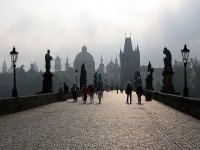
Charles Bridge (Karluv Most)
Visitors to Prague enjoy photographing The Charles Bridge more than any other feature in the city. Built to replace the Judith Bridge (which had been washed away by floods in 1342)…
Charles Bridge (Karluv Most)
Visitors to Prague enjoy photographing The Charles Bridge more than any other feature in the city. Built to replace the Judith Bridge (which had been washed away by floods in 1342), its construction began in 1357 and concluded in the 15th Century. Up until 1841, it was the only bridge in Prague and the only means of crossing the Vltava River. The Charles was closed to traffic in 1978 and has been a pedestrian bridge ever since.
The bridge's 30 statues of saints were originally erected between 1683 and 1714, and create a unique combination of Baroque and Gothic styles. A festive crowd usually strolls across during the day, with throngs of people picking their way through the happy mix of buskers and artists. The bridge is far quieter at night, though, when the crowds have left and only the statues stand guard. Under moonlight, the setting presents some beautiful photo opportunities.

Old Town Square
Prague's Old Town Square has been the heart of the old city since the 11th century and still hosts a variety of markets, such as the whimsical annual Christmas markets. An odd Art …
Old Town Square
Prague's Old Town Square has been the heart of the old city since the 11th century and still hosts a variety of markets, such as the whimsical annual Christmas markets. An odd Art Nouveau monument to the religious reformer, Jan Hus, stands at its centre, while the Old Town Hall features Prague's ornate, Gothic Astronomical Clock. The clock shows three different times and draws throngs of people on the hour, who gather to watch the brief mechanical performance of apostles, Christ, a skeleton and a rooster. Tourists can climb the tower for a behind-the-scenes look at the mechanics of this beautiful clock, and to enjoy a great view of the city from the top.
There are two magnificent churches on opposite sides of the square: Prague's greatest Baroque building, St Nicholas, with its distinctly visible dome, and the even more striking Tyn Church. The latter is a fabulous Gothic structure, its twin spires a noticeable feature on the Prague skyline. This square and its unparalleled Gothic architecture feature prominently on postcards of Prague and it's easy to see why. There are also a number of other attractions in the square or nearby, including the Kafka Museum.

The Jewish Museum
Situated in the old Jewish Quarter, The Jewish Museum's exhibitions are spread over a variety of buildings and synagogues, including the Maisel, Spanish, Klausen and Pinkas Synagog…
The Jewish Museum
Situated in the old Jewish Quarter, The Jewish Museum's exhibitions are spread over a variety of buildings and synagogues, including the Maisel, Spanish, Klausen and Pinkas Synagogues, the Ceremonial Hall, the Old Jewish Cemetery, the Robert Guttmann Gallery and the Education and Culture Centre. The origins of the collection are astonishingly atrocious: objects from 153 Jewish communities throughout Bohemia and Moravia were brought to Prague by the Nazis in 1942, to be used in a planned 'museum of an extinct people' after their extermination programme was complete.
The Pinkas Synagogue was turned into a Jewish memorial after World War II and its walls are covered with the names of the Czech victims, the communities they belonged to and the camps in which they perished. The Old Jewish Cemetery is one of the oldest surviving Jewish burial grounds in the world, while the Old-New Synagogue is the continent's oldest working synagogue.
Website www.jewishmuseum.cz/en/info/visit

Vysehrad
Sitting on a hill above the Vltava River, The Vysehrad Citadel has played an important part in Czech history for over 1,000 years, serving as a royal residence, religious centre an…
Vysehrad
Sitting on a hill above the Vltava River, The Vysehrad Citadel has played an important part in Czech history for over 1,000 years, serving as a royal residence, religious centre and military fortress. Today, many still view the citadel as Prague's spiritual home, the twin spires of its centrepiece, the Church of St Peter and St Paul, visible from as far away as Prague Castle. Behind the church is the Slavin Cemetery, where many distinguished Czech artists, scientists, doctors, poets and academics are buried. The hill also boasts one of Prague's original rotundas, the Rotunda of St Martin, which dates to the 11th century. From the battlements, the view of the Vltava Valley is superb, and many tourists in Prague come to Vysehrad simply to take pictures of the impressive vista.
Website www.praha-vysehrad.cz

Cesky Krumlov
Nestled on the winding River Vltava, Cesky Krumlov's appearance has remained almost unchanged since the 18th century. This small, medieval town in southern Bohemia is a bouquet of …
Cesky Krumlov
Nestled on the winding River Vltava, Cesky Krumlov's appearance has remained almost unchanged since the 18th century. This small, medieval town in southern Bohemia is a bouquet of cobbled lanes, ramshackle red-tiled roofs and colourful houses, all of which provide picture-perfect photo opportunities. Only about two and a half hours outside of Prague, Cesky Krumlov makes for a wonderful weekend trip or overnight excursion.
One of Cesky Krumlov's most famous attractions is the Renaissance-style castle on the hill, a trove of covered walkways, courtyards and terraced gardens that goes back to the 13th century. Castle visitors can expect marvellous views of the town setting. Other famous attractions include the Egon Schiele Art Centrum, the Church of St Vitus and the Czech Marionettes Museum.
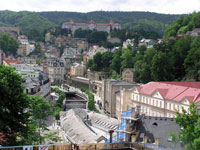
Karlovy Vary (Karlsbad)
Elegant boulevards, elaborate colonnades and brightly coloured buildings line Karlovy Vary's picturesque river valley, testifying to the town's history as a getaway for the aristoc…
Karlovy Vary (Karlsbad)
Elegant boulevards, elaborate colonnades and brightly coloured buildings line Karlovy Vary's picturesque river valley, testifying to the town's history as a getaway for the aristocracy. It is, indeed, the crown jewel of the Czech Republic's many spa resort towns. Tourists typically visit for health purposes, with the town's 12 hot springs garnering most of the attention. The mineral content in the springs is famously rich in restorative properties, historically drawing guests as blue-blooded as Tsar Peter the Great. Today, locals gather to fill their quaint little drinking cups, sipping as they stroll so that the water works its magic on their digestive tracts and metabolic disorders.
As an alternative, many people appreciate the locally made Becherovka liqueur, which is often hailed as the 13th spring. Although most of the spa pools and sanatoriums are reserved for people undergoing treatment, visitors can swim in the heated pool above the Thermal Sanatorium.
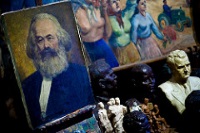
Museum of Communism
The Museum of Communism covers the post-World War II communist regime in Czechoslovakia, offering an eye-opening look at life behind the Iron Curtain, and insight into the experien…
Museum of Communism
The Museum of Communism covers the post-World War II communist regime in Czechoslovakia, offering an eye-opening look at life behind the Iron Curtain, and insight into the experiences of the Czech people during the Soviet era. With genuine artefacts on display, informative text, multimedia presentations and even a reconstructed classroom, interrogation room and Soviet-era factory, the museum presents what it brands 'the dream, the reality, and the nightmare' of communism. Its exhibitions show all aspects of the totalitarian regime, including daily life, the army, education, sport, politics, economics, propaganda, censorship and art. Visitors will leave with a very real sense of what the city has been through.
Website www.muzeumkomunismu.cz
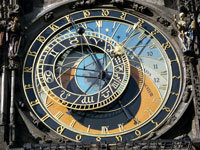
Prague Astronomical Clock
Prague's medieval astronomical clock, also known as the Prague Orloj, is mounted on the southern wall of the Old Town City Hall, and is popular with tourists eager to watch the clo…
Prague Astronomical Clock
Prague's medieval astronomical clock, also known as the Prague Orloj, is mounted on the southern wall of the Old Town City Hall, and is popular with tourists eager to watch the clock's hourly show. The clock has three main components, namely the astronomical dial, which represents the position of the sun and the moon in the sky, 'The Walk of the Apostles' showing moving sculptures, and a calendar dial with medallions representing the 12 months.
The show begins with Death, represented by a skeleton, pulling the bell cord with one hand while holding a Clessidra (hourglass) in the other. The Apostles then come out of the windows in a procession and return back inside. Once the windows close, a cockerel flaps and crows in an alcove followed by the chimes of the hour. The parody is accompanied by the Turk shaking his head, the Miser watching his bag and Vanity admiring himself in a mirror, and makes a wonderful spectacle for visitors to Prague.

Milunic and Gehry's Dancing House
This unique building is so famous, the Czech National Bank issued a coin featuring its likeness in 2005, the final piece in the bank's '10 Centuries of Architecture' series. Design…
Milunic and Gehry's Dancing House
This unique building is so famous, the Czech National Bank issued a coin featuring its likeness in 2005, the final piece in the bank's '10 Centuries of Architecture' series. Designed by Croatian-born Czech architect Vlado Milunic together with renowned Canadian architect Frank Gehry, the building was originally named 'Fred and Ginger', as it looked like a man and a woman (Fred Astaire and Ginger Rogers) dancing together.
The building was designed in 1992 and completed in 1996, and was somewhat controversial, with some thinking it contrasted too starkly with the Art Nouveau style of buildings in its neighbourhood. However, over the years it has become a well-loved and supported landmark in the city, receiving worldwide praise for its innovative design and originality.
The Dancing House was built on a significant site, replacing a building that was destroyed by bombing during World War II. The design is meant to be symbolic of the changes undergone by the Czech Republic from communist regime to parliamentary democracy.
Website www.galinsky.com/buildings/dancinghouse
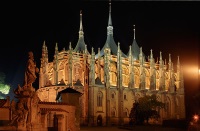
Kutna Hora
This small, interesting town is only about an hour away from Prague. In the 14th century, Kutna Hora became the second biggest town in Bohemia after the discovery of silver ore in …
Kutna Hora
This small, interesting town is only about an hour away from Prague. In the 14th century, Kutna Hora became the second biggest town in Bohemia after the discovery of silver ore in the surrounding hills. Today, visitors come to this UNESCO World Heritage Site to appreciate the history of a once booming place and to marvel at its splendid architecture.
Kutna Hora's greatest monument is the exquisite church of Santa Barbara, which miners financed and dedicated to their patron saint, Barbara, and commissioned to rival Prague's St Vitus Cathedral. The Hradek Mining Museum is popular for its medieval mineshaft tours, while the bizarre but fascinating Gothic Ossuary is decorated with the bones of about 40,000 people.

Petrin Hill
Petrin Hill is in the centre of Prague, perfectly located to offer stunning panoramic views of the picturesque city. Rising above the Vltava River, it is almost entirely covered by…
Petrin Hill
Petrin Hill is in the centre of Prague, perfectly located to offer stunning panoramic views of the picturesque city. Rising above the Vltava River, it is almost entirely covered by recreational areas and parks, and should definitely be on the list of families travelling to Prague, beginning with the funicular ride up the hill.
It is a fun experience for kids, followed by an exciting climb up the miniature TV tower. The tower is a small version of Paris' Eiffel Tower. Called the Petrin Observation Tower, it may not sound tall at 197 feet (60 metres), but it is a vantage point from which to see the whole of Prague.
With breathtaking views, it is well worth the climb of 299 steps, especially on a clear day, when it's possible to see Snezka, the highest peak in the Czech Republic. Kids love finding each other in the bludistì (mirror maze) hall, and pony rides on the hill are also a popular activity.
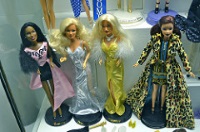
Prague Toy Museum
Housed in the Old Count's Chambers of Prague Castle, the Toy Museum is a wonderful attraction for kids and adults alike. The museum contains several exhibition rooms, takes up two …
Prague Toy Museum
Housed in the Old Count's Chambers of Prague Castle, the Toy Museum is a wonderful attraction for kids and adults alike. The museum contains several exhibition rooms, takes up two floors, and is said to be the second biggest collection of its kind in the world. There are displays of playthings from across the globe and across the centuries, with some of the artefacts dating as far back as Ancient Greece. The museum's comprehensive Barbie collection is chronological and displays the changes in fashion that Barbie has undergone over the generations. Unsurprisingly, the Barbie collection is a favourite with little girls. Other highlights include the mechanical toy trains and the huge collection of teddy bears. There are also traditional Czech dolls and toys, which offer some fun insight into the culture.
Website www.muzeumhracekpraha.cz/en
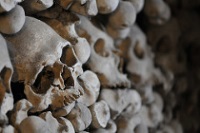
Kostnice Ossuary
The Kostnice Ossuary, also known as the Sedlec Ossuary or the Church of Bones, is a unique experience for intrepid travellers. The medieval Gothic chapel is decorated with the rema…
Kostnice Ossuary
The Kostnice Ossuary, also known as the Sedlec Ossuary or the Church of Bones, is a unique experience for intrepid travellers. The medieval Gothic chapel is decorated with the remains of about 40,000 human skeletons, including an immense chandelier. While it is considered macabre by some, the skeletons belonged to people who wished to be buried in the Ossuary, which they considered a holy place. According to the display, they were all victims of the plague.
The famous chandelier contains at least one example of every bone in the human body, and there are other sculptures and decorations also pieced together intricately with bones. Though the effect is remarkably artistic, the Ossuary is a sacred place and the atmosphere is one of worship and peace. It's worth reading up on the history of the Ossuary and the area before visiting the chapel, as the experience is greatly enriched by some background knowledge.
Website www.sedlecossuary.com

Sumava National Park
Sumava National Park is one of the Czech Republic's best treasures. Located in two southern regions, the area contains the largest primeval forested area on the continent and is a …
Sumava National Park
Sumava National Park is one of the Czech Republic's best treasures. Located in two southern regions, the area contains the largest primeval forested area on the continent and is a UNESCO Biosphere Reserve. The striking landscape features lush green mountains, rushing streams, raised peat bogs and crystal-clear glacial lakes. Hikers can expect a wonderful selection of trails, whether they intend trekking through forest or heading to the lookout tower at the top of Poledník mountain.
The park's resorts are a must for skiers during winter, while Lake Lipno is a summer haven for water sports. Spring is popular with nature lovers, as it is the best time to see the park's array of flowers and birds. Autumn, on the other hand, is a riot of colours and is equally spectacular. Visitors can choose a hotel or cottage in the park itself, or stay in one of the historic towns on its edge. These include Prachatice, Cesky Krumlov and Kasperske Hory.
Website www.npsumava.cz/en/2004/sekce/homepage
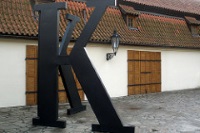
Franz Kafka Museum
Born in Prague in 1883, renowned author, Franz Kafka, would later refer to the city as his 'dear little mother with claws'. This museum delves into why, covering Prague's influence…
Franz Kafka Museum
Born in Prague in 1883, renowned author, Franz Kafka, would later refer to the city as his 'dear little mother with claws'. This museum delves into why, covering Prague's influence on the man and his most famous works, including The Metamorphosis and The Trial. Through facsimiles of manuscripts, photographs, newspaper obits, and audio-visual exhibitions, the museum looks to immerse visitors in the dark, magical and mysterious place that is the author's Prague. Booklovers may enjoy the extensive personal correspondence on display, which allows great insight into Kafka and his life. The museum is definitely worth a visit, though it's not for children.
Website www.kafkamuseum.cz

Pilsen
This small town in Bohemia has a brewing tradition that goes back centuries. King Wenceslaus II of Bohemia founded the City of Pilsen in 1295 and gave its 260 citizens the lucrativ…
Pilsen
This small town in Bohemia has a brewing tradition that goes back centuries. King Wenceslaus II of Bohemia founded the City of Pilsen in 1295 and gave its 260 citizens the lucrative right to brew the beer, spawning more than 200 microbreweries. In turn, they developed the famous Pilsner brewing methods that still produce some of the best beer in the world. The Pilsner Urquell Brewery opened in 1842 and continues to be Pilsen's main attraction, its two separate breweries making Pilsner Urquell and Gambrinus respectively. Visitors can tour both breweries and can learn about the history of beer at the museum.
Pilsen also has a variety of museums dedicated to everything from ethnography and history to puppets. The town itself is pleasant to walk through and has some beautiful buildings to see, including the 15th-century Town Hall, the Cathedral of St Bartholomew and the Great Synagogue. As might be expected in a town famous for its beer, Pilsen has a lot to offer regarding restaurants and pubs. There are many places to try local Czech cuisine, and bars serve coveted unfiltered beers, which are considered far superior to the filtered exports.
Website www.prazdroj.cz



